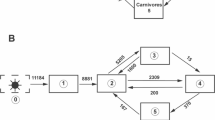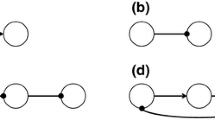Abstract
Health, it is argued, implies that a system has an optimum state that can be defended. For organisms and populations this can be understood objectively and generally in terms of neo-Darwinian principles. Similar reasoning cannot be applied to ecosystems. The possible advantages and difficulties of applying this concept of health to ecosystems are critically considered.
Similar content being viewed by others
References
Armitage, P. D., R. J. M. Gunn, M. T. Furse, J. F. Wright & D. Moss, 1987. The use of prediction to assess macroinvertebrate response to river regulation. Hydrobiologia 44: 25–33.
Blanck, H., S. Wangberg & S. Molander, 1988. Pollution-induced community tolerance — a new ecotoxicological tool. In: J. Cairns & J. R. Pratt (eds), Functional Testing of Aquatic Biota for Estimating Hazards of chemicals. Amer. Soc. Testing & Materials, STP 988: 219–230.
Cairns, J. & J. R. Pratt, 1986. On the relation between structural and functional analyses of ecosystems. Environ. Toxicol. Chem. 5: 785–786.
Calow, P., 1976. Biological Machines. A Cybernetic Approach to Life. Edward Arnold, London, 134 pp.
Calow, P., 1984. Factors affecting the diversity of littoral invertebrates: a hypothesis. Ing. Sanitaria 30: 41–46.
Calow, P., 1991. Physiological costs of combating chemical toxicants: ecological implications. Comp. Biochem. Physiol. 100C: 3–6.
Calow, P. & R. M. Sibly, 1990. A physiological basis of population processes: ecotoxicological implications. Func. Ecol. 4: 282–288.
Cook, S. C. A., C. Lefebvre & T. McNeilly, 1972. Competition between metal tolerant and normal plant populations on normal soil. Evolution 26: 366–372.
Dawkins, R., 1982. The Extended Phenotype. Freeman, London. 307 pp.
Grime, J. P., 1979. Plant Strategies and Vegetation Processes. John Wiley, Chichester. 222 pp.
Hutton, J., 1788. Theory of the earth; or an investigation of laws observable in the composition, dissolution and restoration of land upon the globe. Trans. Roy. Soc. Edinburgh 1: 209–304.
Lovelock, J., 1988. The Ages of Gaia. Oxford Univ. Press, Oxford. 252 pp.
MacArthur, R. H., 1965. Patterns of species diversity. Biol. Rev. 40: 510–533.
May, R. M., 1972. Will a large complex system be stable? Nature 238: 414.
May, R. M., 1976. Patterns in multi-species communities. In: R. M. May (ed.), Theoretical Ecology: Principles and Applications, pp. 142–162. Blackwell Sci. Pub., Oxford.
Maynard Smith, J., 1984. The population as a unit of selection. In: B. Shorrocks (ed.), Evolutionary Ecology, pp. 193–202. Blackwell Sci. Pub., Oxford.
Naylor, C., L. Maltby & P. Calow, 1989. Scope for growth in Gammarus pulex, a freshwater detritivore. Hydrobiologia 188–189: 517–523.
Odum, E. P., 1985. Trends expected in stressed ecosystems. BioScience 35: 419–422.
Pimm, S. L., 1979. Complexity and stability: another look at MacArthur's original hypothesis. Oikos 33: 351–357.
Rapport, D. J., 1989a. Symptoms of pathology in the Gulf of Bothnia (Baltic Sea): ecosystems response to stress from human activity. Biol. J. Linnean Soc. 37: 33–49.
Rapport, D. J., 1989b. What constitutes ecosystem health? Perspect. Biol. Med. 33: 120–132.
Rapport, D. J., H. A. Regier & T. C. Hutchinson, 1985. Ecosystem behaviour under stress. Amer. Natur. 125: 617–640.
Schaeffer, D. J., E. E. Herricks & H. W. Kerster, 1988. Ecosystem Health: 1. Measuring ecosystem health. Environ. Managem. 12: 445–455.
Sibly, R. M. & P. Calow, 1989. A life-cycle theory of response to stress. Biol. J. Linnean Soc. 37: 101–116.
Townsend, C. R., 1989. The patch dynamics concept of stream community ecology. J. North Amer. Benthol. Soc. 8: 36–50.
Westman, W. E., 1978. Measuring the inertia and resilience of ecosystems. BioScience 28: 705–710.
Wright, J. F., P. D. Armitage & M. T. Furse, 1989. Prediction of invertebrate communities using stream measurements. Regulated Rivers: Res. Managem. 4: 147–155.
Author information
Authors and Affiliations
Rights and permissions
About this article
Cite this article
Calow, P. Can ecosystems be healthy? Critical consideration of concepts. J Aquat Ecosyst Stress Recov 1, 1–5 (1992). https://doi.org/10.1007/BF00044403
Issue Date:
DOI: https://doi.org/10.1007/BF00044403




